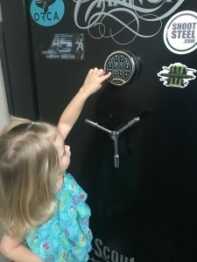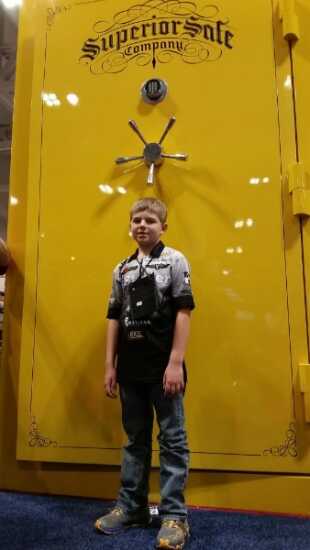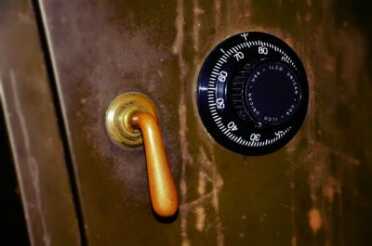
If kids can see it, they will try to get it. Keep your firearms locked up and safe!
Introduction:
The Kids and Guns series began with a look at guns as part of our American heritage and how the views that our children hold are influenced by the role that guns play in their lives. Part of setting the stage for that role is safety. In this piece, we are going to discuss safe storage of firearms.
I’m going to tell you some of what I do, but I’m not going to tell you everything because you need to choose what is right for you and your family. And, while storing guns safely must always be a priority, storing guns when you have children in the house can be much different than storing guns when you don’t. Your kids are different than my kids, and from your neighbor’s kids. We need to understand that we can’t take a cookie-cutter approach to keeping our families and guns safe.
The Series
- The Basics
- Storage
- Teaching
- Rimfire
- Hunting
- Competitive Shooting
- Shotguns
- Pistols
- Revolvers
- Older kids
- Tactical Kids

Hear no evil, see no evil, speak no evil. Sometimes gun owners can be reluctant to talk about how they store guns.
Talking About Storage
Some people take a “don’t ask, don’t tell” approach to gun storage. Talking about where you store your guns with your friends is different than talking about where you store your guns with the public. There are two sides to be considered in the cost/benefit evaluation of securing firearms: on the one hand, if it’s locked, you cannot access it as quickly when you need it; on the flip side, if it’s locked those who don’t need it can’t get it. We have to find a middle ground, some place between pegs over the fireplace mantel and a biometric security system. We have to plan to secure our firearms from Houdini-like toddlers, yet still have them readily available when needed.
But HOW do you store your guns when you have kids? This is going to depend on your kids, your lifestyle, and your family and friends. If you live in a neighborhood, like a good friend of mine, and there’s a chance that you might come home from work to find a neighborhood girl eating a hotdog in your kitchen — and nobody else in your house — then you’re going to want to very securely lock up your firearms! If you live with teenagers who compete in shooting sports and practice with guns on a daily basis, your needs are going to be very different. There’s no “one size fits all” when it comes to guns, whether it carrying them, shooting them or storing them!
Step 1 – Assess
What do you have? Why do you have it? I might use a gun to compete, but not to hunt. You might use a gun to keep livestock safe from predators. Someone else might need a gun because their job requires it (LEO & military). Based on the utility of the firearms you have, you can then decide where and how to store them. In all these situations, we should consider what happens if someone who shouldn’t have access to our guns suddenly and without permission gains access to them.
How many layers do you need? By layers, I mean things like a safe, a trigger lock, or a separate lock box for ammo (maybe you have some really smart kids who want to investigate everything). Do you own a business and need to conceal your safe? You want to store your guns and ammo separate from each other, especially with kids around, but what’s the best way for YOU to do that? You have to do some research and fairly assess your situation and the children in your house.
Step 2 – Research

Little people sometimes call for BIG effort when it comes to keeping them safe.
One place to start your assessment is Project Childsafe. They have many helpful links, including links to various types of safes and locks as well as links to firearms safety seminars at accessible locations like your local Bass Pro Shop and other venues where you and your kids can learn together. Even handling guns to store them requires a basic understanding of the rules of firearms safety.
The NRA’s Eddie Eagle program isn’t gun safety training per se or a firearms storage guideline, but it provides insight you should consider. It is geared toward awareness. Its target audience is the youngest crowd, the kids who don’t understand the implications of the word “firearm” because they’re not old enough. The goal of the program is to instill a sense that the object they’ve encountered is something they should tell an adult about right away. They should do this not out of fear, but to inform the big people that the little people can see it, because if they see it, they can probably get it. While one particular child may have no intention of laying hands on it, some other little person might. The goal of Eddie Eagle is to teach youngsters, as the slogan goes, “Stop. Don’t touch. Leave the area. Tell an adult.”
In addition to knowing what kids can see, we should also have a clear idea of how well they understand firearms. If you shoot infrequently or only have a firearm for home defense, your kids might not have ever handled a gun, and that’s a much different scenario than kids of parents who shoot or hunt often. For a parent of toddlers, understanding what they know about guns might mean any guns not in a big safe are in lock boxes. For a parent of teens that do competitive shooting, this might mean they have access to specific firearms as well as parameters set on where they can dry fire and where ammunition is kept. For parents with a neighborhood gaggle of kids coming and going through their home, this might mean guns are kept in a completely separate area of the house that kids cannot access.
Step 3 – Shop Around
Now that you’ve assessed your needs, and established some of the things you need to take into account, you should shop around. Don’t just rush out and buy something in haste. Guns are not going to wander off, like a goat looking for brass to eat. Check out your friend’s safes by asking them (if they are comfortable discussing this) how many guns they have and where they keep them. (This is not a joke, so make sure they’re good friends or they might not be so forthcoming.) You’ll often see some innovative things like safe doors placed into reinforced walls, or inexpensive safes bolted to the studs of a closet from inside the safe. You might get to see safes with door pockets, adjustable shelves, configurable racks, or even old, old safes that were never intended for guns, but were cheap and built like a bunker.

An old safe, not initially intended for guns, but it works great.
Maybe you want to build a safe room! There are plenty of articles that lay out considerations like moisture, size ,etc. I’ve seen garage safe rooms with a safe door and reinforced walls, basement safe rooms with extra concrete and locking doors. If you have a walk-in closet with a door that your gun safe can fit through, you could fit a solid core door with a deadbolt, reinforce the door frame, and have a safe room pretty simply.
You might need a small, single gun safe or lock box that you can access quickly. One option parents with small children who don’t need a big safe often use are speed vaults. If I have a curious toddler who investigates everything, I can’t leave a gun in a place I can get to fast, because there is a chance they can get it also. A speed vault is a great option for gun owners who only own a single weapon or want fast access to one for self-defense.
Shopping for a safe can be fun too – once you’ve considered all the safety and legal ramifications that come with owning guns, then you can focus on the cool safes and storage solutions.

Competitive shooter, Dillen Easley says that, “With my three children (ages 3, 5, and 7), accidents are unacceptable, especially when completely avoidable. We have set a room aside for competition gear, reloading equipment, and safe storage of firearms. That room remains locked at all times, and the firearms safe has its own locking system as well. Part of protecting our rights is realizing our responsibilities and taking them seriously. Our home defense firearms are kept secure, and out of reach, in similar areas in the house.”
Step 4 – Implement the Plan
Once you decide what you want to buy and you have it, use it right! Don’t leave guns out that belong inside, don’t leave the key on top of the safe, don’t tape the code to the door of safe. Put these things where you or other adults will be able to access them, but not the children! And practice getting into your safe. Can you get in without light? Can your spouse do it?
One plan I like for families with toddlers is putting things out of sight and out of mind. Fellow competitive shooter, Dillen Easley, not only locks his guns up, but his ammo and reloading equipment as well. An entire locked room is part of their family’s plan, because he recognizes that his children’s lives are too precious and that a plan for storage keeps them safe.
My favorite safe is the one made up of an invisible substance: knowledge. Knowledge of where MY gun is secured, what condition it’s in (chamber empty but mag inserted, etc.), knowledge of what I have to do to access it, and who else knows about it. The best thing you can do for yourself and your kids is to share the knowledge. So get a plan, learn it, and use it. We use a combination of safes, plans, and rules. I personally think that the rules and sticking to them are the most important part of storing your firearms!
Step 5 – Monitor Effectiveness
Once I have implemented my plan and I’ve lived with it for a while, I should monitor its effectiveness. Are the measures I’m taking necessary and working? If my kids are young and curious, I probably don’t want to bring them into this activity. I might watch them when I’m going into the safe and see if they know how to work it, or simply ensure they are not around to observe when I am accessing it. I might check if they’ve somehow used their genius child brain to crack the safe’s access code on the keypad. If my kids are older, I should talk with them, I should ask if this has kept our firearms safe when their friends are visiting. Do they actually know how to access the guns?
In addition to the children, what about your spouse? I know many husbands joke about not wanting their wives to know how many guns they have, but your spouse SHOULD know the access code or where a key is, and be able to use the home-defense firearms. This step might make us realize that we need to take our spouse to the range so they can take an active role in storing firearms. Every adult should know where and how to access the guns the family owns, as well as how to put them away safely.
Conclusion

Safes come in all shapes and sizes, but using one is the most important part of owning a gun safe.
The best thing we can to do to keep kids and our guns safe is to teach them. Teach them safe firearms handling, to be aware of their surroundings and who they are with, and to put their guns away when they’re not at home. We need to stay aware of the fast-changing skills of children. Because honestly, once you have kids, everything is dangerous. They’re inching you toward your grave, one gray hair at a time. Don’t give them any wiggle room when it comes to firearms. Lock up what they shouldn’t have, train them not to touch, and once they’re older and can begin internalizing the safety rules, you will need to reassess how you store guns.
On a side note, I’m writing this while on the road traveling, my husband at work in his patrol car. My 16 and 11-year old children are at home. I know their understanding of safety and their skill in handling firearms. My mind is at peace that they are safe with the guns. The new tree swing is another concern!

As someone who works with children in elementary and middle school, I would like to stress that the mental health of the kids always needs to be assessed. I do plan to introduce my future children to firearms. However, if I notice serious depression/anti-social behavior, the plan will change quickly. I may even (gasp) elect to not keep firearms in the house, if I thought a desperate enough teenager might get to them – and I couldn’t find them an appropriate outpatient placement. I am empathetic to parents that do not want to imagine that possibility, but as responsible firearm owners, we have to consider every possibility.
I wish organizations that teach firearm safety would more often bring up mental health. It’s starting to happen, but I want that to roll out faster.
Great article, by the way!
I have always owned guns since legal age. Grew up with them. I am getting close to 50. Retired military….much spent living in base housing. Now that I own a house, I have a safe. But not all of my guns are in it. I believe that any gun that is outside the safe should be loaded….YES LOADED. It may be put up to where its hidden or out of reach of little ones….but they are loaded and always have been. I have raised 5 children successfully, never had an incident….even through numerous deployments (ie. times I wasn’t home for long periods of time). Taught my kids about firearms from the time they could talk. Yes, I said “talk”. It starts with the words they learn and know and the meaning behind them. Its actually called parenting. Seems to have become an elusive “superpower” these days. Make no mistake, good parents have this super power….and use it continuously. That is the true breakdown in our society today….lack of parenting. Point being….its all in what and how you teach them.
I’m a gun dealer, collector, and hunter. A lot of guns have passed through my hands and home. I kept no loaded guns in the house when our kids were young (they’re now in their 20s) . Our rule was that they could handle any gun that I brought home as long as my wife or I handed it to them. That way we could demonstrate safe gun handling to them, such as pointing in a safe direction, keeping one’s finger off the trigger, etc. This mirrors the author’s point #4.
Pete, Sounds like you did exactly what parents should do: teach and supervise! And now your kids can pass that down to their children!